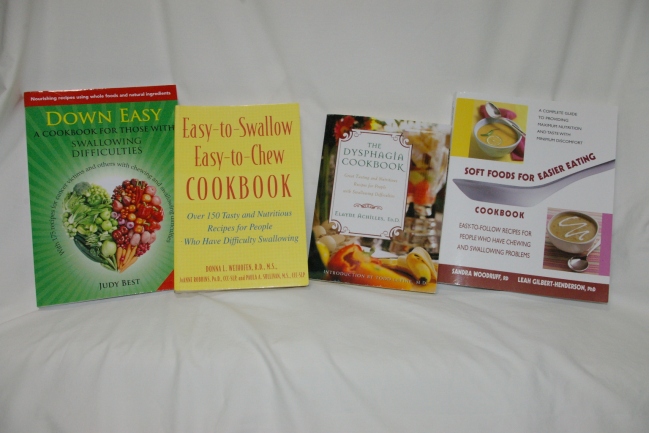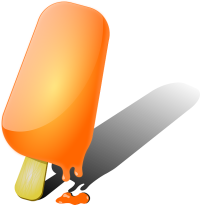Tips for Thickening Nutritional Supplements
Posted: April 1, 2016 Filed under: eating, How-to video, Nutrition, Strategies, support for dysphagia, support for feeding | Tags: Boost, Dysphagia, Ensure, new products, nutrition, Nutritional Shakes, Supplements 6 CommentsIf you are on thickened liquids, how can you safely drink pre-made nutritional shakes like Boost and Ensure? This video will help answer your questions.
“How to Puree Just About Everything” – A How-To Video
Posted: September 24, 2015 Filed under: Cookbook, Cooking, eating, How-to video, Nutrition, Online support, Purees, Real Food, support for dysphagia, support for feeding | Tags: How-to video Leave a commentThough I haven’t posted recently, I have been busy.
I am in the process of filming cooking lessons on the techniques neccessary to puree almost every food. There will be five lessons in all.
The cooking lessons will be on a DVD that will be included in the purchase of my care manual “Making Every Bite Count”. Because this information is essential to living on a puree diet, I hope to make all the full length videos available to view online for a small fee.
Through these cooking lessons, I will show you how to modify the foods you love so you can still eat them if you are on a puree diet.
First up: Meat
Pureeing meat can be a real challenge! Cooked meats can be hard to puree because meat protein form tight bundles that need can be difficult to chew, let alone puree. When pureeing meat, keep in mind that:
- you need to start-out with cooked meat
- meats that are easier to chew will also be easier to puree
- you’ll need broth or other cooking liquid
- you’ll need an instant food thickener to bind the puree into a cohesive mass for safe swallowing
- purees don’t have to be soupy
- purees can taste great!
This video is just a snap-shot of the full video, so take a look and get some ideas!
Perfectly Safe Popsicles
Posted: May 20, 2015 Filed under: Cooking, eating, How-to video, Hydration, Nutrition, Real Food, recipe, Recipes | Tags: advice, Dysphagia, Eating with Dysphagia, food, How-to video, living with swallowing problems, Recipes, thickened liquids Leave a commentIf you’ve been prescribed thickened liquids and you miss eating ice cream and other frozen treats, this video will help you
Nourishing Independence with Mom’s Meals
Posted: August 13, 2014 Filed under: Care-giving, Caregiving, major life events, new products, Nutrition, Online support, pre-made meals, pre-made purees, Purees, Real Food, Reviews, Uncategorized | Tags: advice, assistance, care-giving, Dysphagia, eating, Eating with Dysphagia, food, nutrition, Pureed Foods, Purees, Stroke, support Leave a commentRecently, I worked with a client who had just returned home after six weeks in hospital and rehab. “Irene” had been a vital, active 78 year-old woman before her stroke. More than anything, Irene and her husband “Bob” want to get their lives back to normal.
Since Irene has arrived home, Bob has been working overtime managing all of the activities that come with recovery from stroke including: scheduling doctor’s appointments then going to the appointments, ordering and receiving a hospital bed and wheel chair, juggling therapy visits, picking-up prescriptions, making the house wheel chair friendly and opening all the mail that accumulates while you are occupied away from home, just to name a few.
Bob asked me to help him learn how to cook for and feed Irene. Before the stroke, cooking was Irene’s job in the family but Bob will do anything it takes to care for his wife, including learning how to cook at 78 years-old! Being a bit overwhelmed, Bob has no time to cook for himself, let alone cook and then puree meals for Irene. I’m glad that there are foods like Mom’s Meals – Purees to recommend to him.
Mom’s Meals is an online supplier fresh-cooked, ready-made refrigerated pureed meals. Each meal has a main dish, vegetable and dessert. Their menu consists of comfort foods like:
- Scrambled Eggs with Brown Sugar Pork Loin Bacon, Bread and Applesauce
- Roast Beef with Gravy, Mashed Potatoes, Brown Sugar Glazed Carrots, Vanilla Pudding and Applesauce
- Pork with BBQ Sauce, Cheese Mashed Potatoes, Green Beans, Fruit and Chocolate Pudding
- Roasted White-meat Chicken with Gravy, Mashed Potatoes, Green Beans and Carrots, Fruit and Vanilla Pudding
- Pasta with Marinara Sauce and Broccoli, Blueberry Applesauce and Pudding
You order online (or by phone) and Mom’s Meals ships directly to your home. The meals have a 14 day shelf life and are easily reheated in the microwave.
I sampled four meals and I found them delicious and hearty. At between 600 and 700 calories per meal, they are ideal for helping to rebuild your strength. With four breakfast menus and eight lunch/dinner choices, you have some ability to eat a variety of foods. If you like home-cooking, Mom’s Meals purees will appeal to you, as they did to Irene and Bob.
Each full puree meal is $7.49 plus shipping. Shipping is $14.95 regardless of the size of your order.
And if you are too busy to cook, like Bob, check-out their regular meals, as well!
To order from Mom’s Meals purees visit their website: http://www.momsmeals.com/independent-at-home/pureed-menu/.
If you need advice, please contact me: laura@dysphagiasupplies.com or 480-266-5622.
Finally, a new Care Manual!
Posted: August 7, 2014 Filed under: care manual, Care-giving, Caregiving, Cookbook, Cooking, Nutrition, Purees, Real Food, Recipes, Strategies | Tags: advice, Cooking, Dysphagia, eating, Modified foods, nutrition, Swallowing Disorders Leave a commentI’ve developed a tool for living with a diagnosis of dysphagia, it is called:
“Making Every Bite Count”
Cooking for Someone with a Swallowing Problem
This care manual helps you how to manage your condition and
keeps your information and research organized
It includes:
• Basic nutrition and how to make every bite count for someone who is having trouble getting enough to eat and drink by mouth.
• How to incorporate the standards of the National Dysphagia Diet into your normal eating habits.
• “How to Puree Just About Everything” – a cookbook with simple techniques on how to modify common, everyday foods.
• Delicious, easy recipes that the whole family can enjoy.
• Updated lists of regular, pre-made modified foods found in most grocery stores.
• Reviews of protein-calorie enhancers, specialty nutritional products, kitchen equipment and more!
• A swallowing screening tool.
• Pre-punched pages for monthly updates.
• Pockets and sleeves for keeping your paperwork and doctors’ orders in one place.
The purchase of this care manual also includes a monthly email update with seasonal recipes, advice, new product introductions and the latest information on webinars and support groups for living with or caring for someone with swallowing problems.
For more information or to order this care manual, please visit my website: http://www.dysphagiasolutions.com
Finding the “New Normal”
Posted: June 12, 2014 Filed under: Alzheimer's, Care-giving, Dementia, major life events, Nutrition, Purees, Real Food, Strategies, Stroke | Tags: assistance, care-giving, Dysphagia, Stroke, support Leave a commentYears ago, when I brought home my newborn son, I stumbled as I tried to find my “new normal”. Major life events mean that life has to change in a big way. The “normal – normal” seems to no longer exist.
Those first few weeks of caring for a totally dependent new life were exhausting, scary, “real” and totally overwhelming. Days were measured by feedings, naps and diapers. Since eating is such a basic part of living, I expected that feeding my son would come naturally. It didn’t. We had challenges. I met with Lactation Specialists in the hospital. I read everything I could get my hands on. What helped me most was reaching-out to other moms and getting advice. Slowly, as I became more comfortable and confident in my role as mommy/care-giver and after my son started eating regularly, the days started to make sense.
I like to compare my experience as a new mom to what families go through when a loved-one is sent home from the hospital after a stroke or other debilitating illness. Care-givers are thrust into roles they’ve probably never before navigated or at least have never practiced on their wife or husband or parent. Many people are often unprepared for the realities of managing the demands of cooking for someone with a swallowing disorder. Unfortunately, the “old way” of preparing meals won’t work anymore and the transition can be difficult. There are no “pureed diet” cooking shows on the Food Network. No famous chef has written a book about how to make pureed foods and beverages safe, nutritious and delicious…but I have.
I have dedicated my life to helping people eat, drink and return as close to “normal” as possible, as they navigate the road to recovery at home. During the ten years I spent working with staffs in hospitals, rehabilitation units and long-term care facilities, I taught many people how to properly manage foods and beverages for their patients with dysphagia. What I teach isn’t difficult or expensive but it can be critical to caring for someone who is living with a swallowing disorder.
The “new normal” will come with time and with a little instruction, a dose of creativity, and the right products. You can help restore the joy of eating and drinking to someone who is living with dysphagia.
If you need help or assistance, please contact me: laura@dysphagiasupplies.com
The Perfect Puree Day by Laura Michael
Posted: June 8, 2014 Filed under: Care-giving, Cooking, Nutrition, Strategies, Uncategorized | Tags: advice, Dysphagia, Eating with Dysphagia, food Leave a commentGetting proper nutrition can be difficult when you have trouble swallowing. The inability to eat the right foods safely can lead to malnutrition. Maintaining proper nutritional intake is a key to overall good health and a high quality of life1. The National Dysphagia Diet2 defined the standard of what pureed food is, but offers little information on how to incorporate pureed foods into an active lifestyle.
The Challenge: Is it possible to eat healthy and well on a puree diet without using your blender or food processor? Can you still eat out? Yes! Let’s answer that challenge by offering breakfast, lunch, and dinner options for those on a modified diet.
Breakfast. Pre-made smoothies, available in the freezer case at most grocery stores, are a good option. Custom-made smoothies can be found at Whole Foods®, Einstein Bros.®, McDonalds®, Starbucks® or any juice bar. Smoothies that contain…
View original post 937 more words
Cookbook Review – Part 1
Posted: May 31, 2014 Filed under: Care-giving, Cookbook, Cooking, Esophageal cancer, Nutrition, Oral Cancer, Recipes, Strategies | Tags: advice, Cancer Diet, Cookbook Review, Dysphagia, Oral cancer, Pureed Foods, Purees, Stroke, Swallowing Disorders Leave a commentAs a teacher and trainer of the National Dysphagia Diet, I am always looking for ways to help my clients eat better.
My goal is to see people enjoy the foods and beverages that they can eat and drink. I like to stay up-to-date on research and publications, so I decided to take a look at some of the cookbooks that were written specifically for people who are living with swallowing disorders.
First, a disclaimer: I am a passionate cookbook reader and collector! I currently have more than 100 cookbooks in my collection. I subscribe to every food magazine that is currently published and I can’t seem to part with my 20 year collection of the now defunct “Gourmet” magazine. If you called me a “food-wonk”, you would not be far off!
I chose to review the four best-selling “Dysphagia Cookbooks” on Amazon:
- “Soft Foods for Easier Eating Cookbook” by Sandra Woodruff, R.D. and Leah Gilbert-Henderson, Ph.D.
- “Down Easy: A cookbook for those with swallowing difficulties” by Judy Best
- “Easy-to-Swallow, Easy-to-Chew Cookbook” by Donna L. Weihofen,, R.D., M.S, JoAnne Robbins, Ph.D., CCC-SLP, and Paula A. Sullivan, M.S., CCC-SLP
- “The Dysphagia Cookbook” by Elayne Achilles, Ed.D.
Each is well written and insightful but there are specifics that are unique to each book.
As I read through and tested the recipes in each of these cookbooks I came to realize that each is a “labor of love” for the author. If you purchase one of these books, I encourage you to read the forewords and acknowledgements as you will find something of value in each.
In my next blog, I’ll go into detail on the pros and cons of each book.
If you can’t wait until my next blog post, please contact me at Laura@dysphagiasupplies.com and I’ll email you the full review.
Having Trouble Swallowing? Strategies for Staying Hydrated.
Posted: May 27, 2014 Filed under: Hydration, Nutrition, recipe, Strategies | Tags: Dysphagia, hydration, ice pops, nutrition, popsicles, trouble swallowing 2 CommentsWhen you have trouble taking foods and liquids by mouth, it can be especially challenging to get enough hydration. People who must consume thickened liquids are often put-off by the flavor and texture of older, starch-based thickeners. New xanthan gum-based thickeners like ThickenUp® Clear taste better, mix easily and don’t continue to thicken upon standing.
Convenience is also an important factor in getting enough to drink. It is easier to just “grab and go” water, juices and other beverages that have been thickened in bulk and kept readily available in the refrigerator. Commercially prepared thickened beverages provide a consistent supply of thickened liquids but can be a bit more expensive than thickening liquids at home.
Individuals who have limited mobility and who have dysphagia are at high risk for dehydration because they must depend on others to meet their need for liquids. Keeping cool thickened beverages within arms-reach is essential but can be a challenge. One solution is to make ice cube with water that has been thickened to the proper consistency with a xanthan gum thickener, like ThickenUp® Clear and then using the ice cubes in drinks kept within easy reach. Do not make ice cubes with starch-thickened water because they brake-down into particles as they melt, causing an unsafe texture. “Regular” ice cubes are dangerous for people on thickened liquids because, as they melt, they thin-out the consistency of the beverage.
Eating foods like soups, smoothies, yogurt and other foods that naturally have a high liquid content can also help to combat dehydration. “Perfectly Safe Popsicles” are also a great way to encourage hydration. If you want the recipe, send me an email: laura@dysphagiasupplies.com.
What are some recommendations you might have for staying hydrated? Please share in the “comment” section of this blog.
As mentioned in a previous blog: dehydration can be exacerbated by the use of diuretics, laxatives, antidepressants, certain antibiotics and other medications. Please consult your Pharmacist about your specific medications if you have questions or concerns.
Dehydration can be very serious. Severe dehydration can lead to hospitalization.
The key to preventing dehydration is simple: Avoid it. Be aware of what you are drinking and consume more liquids!
Water is an essential element for sustaining life. The human body is composed of more than 60% water.
Without water, we won’t survive for more than a few days.






Recent Comments